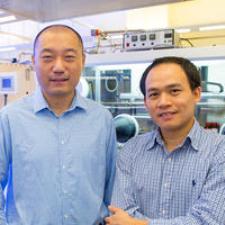Jul 23 2015
Researchers at Florida State University (FSU) have developed new functional materials with tailored properties and well-defined structures that make them desirable for applications including light-controlling devices and molecular sensors.
 Associate Professors Biwu Ma and Chen Huang.
Associate Professors Biwu Ma and Chen Huang.
Biwu Ma, an associate professor of Chemical and Biomedical Engineering, and Chen Huang, an assistant professor of Scientific Computing at FSU, have collaborated in this study to create new materials. They have designed and created molecular butterflies as new functional materials.
These molecular butterflies have the ability to emit red, white and blue colors when controlled. These colors have different energy levels that can be used in various methods.
The team intends to further its study by finding out the ways to control and direct energy of larger quantities, and to convert photo energy into heat, molecular motion, electricity or light whenever desired. The study could help develop devices with better efficiency, such as solar panels, light bulbs and sensors. Furthermore, materials with better qualities could also be developed.
We were able to develop new functional materials with well-defined structures and tailored properties in a rational manner by combining experimental and computational expertise. We have created these new molecules that behave exactly the way we want. We call it materials by design.
Biwu Ma, an associate professor of Chemical and Biomedical Engineering
Ma had written about the first molecular butterfly created by him in the lab in the Angewandte Chemie last year. This molecular butterfly could “flap its wings” and this could lead to creation of two photo excitation states. This is due to photo-induced structural change, and blue and red would be emitted simultaneously at a specific ratio. Typically, a molecule would emit one color light, as it would have one excited state. The ability of this molecular butterfly to have two states and dual emission of color is a unique property.
Ma and Huang raised the question of what would take place when a family of molecules was involved?
FSU hired Ma in 2013 and Huang in 2014. Huang is a theorist, while Ma is an experimentalist. Huang analyzes mathematical equations and studies the reason behind the behavior of materials. Ma practically creates materials in the lab to practically find out what happens.
Huang and Ma joined together to fine tune the molecular compound that was originally used for creating the first butterfly. They finally developed several molecules that varied very slightly in terms of size and composition.
Computational tools helped the researchers to find out ways to design the new molecules and make them act in the exact manner desired. Based on the molecular design, the researchers were able to create various energy wavelengths at different times.
It’s a matter of fundamental understanding of the structure-property relationships. With powerful computational tools, we can gain insights on how the molecular properties are determined by the structure and come up with the molecular design rules.
Huang
This research paper has been featured on the front cover of the journal, Angewandte Chemie.
Other authors who contributed to this paper include Chenkun Zhou, Zhao Yuan, Jamie Wang, Maliheh Shaban Tameh, Yu Tian, Mingu Han, and Lei Zhu.
FSU has provided funding for the research conducted by Ma and Huang. FSU had initiated an Energy & Materials Strategic Faculty Hiring Initiative to advance scientific discovery in this growing field.
References